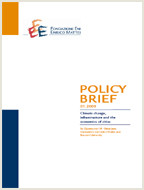Assessing the climate pledges of China and India: how much do they bite?
One of the most important outcomes of Copenhagen has been the pledge of China and India to reduce the carbon intensity of their economies. The former is especially relevant since China already generates 25% more emissions than the second world country emitter, the US. Recent statements of Chinese officials indicate that the commitment might already be included into the twelfth five year plan (2011-2015), to be approved early next year. If that was the case, China would have a domestic climate policy before more accountable nations such as the US do. However, given the elusive intensity metric, there is considerable speculation about what kind of climate leadership is entailed by the Copenhagen pledges. This policy brief tackles this issue by providing an assessment of the Asian giants’ efforts required to meet their climate goals, and the implications beyond 2020. Historical evidence and results of integrated assessment models point to a mixed picture in which the accord can turn from business as usual to a serious climate policy.

